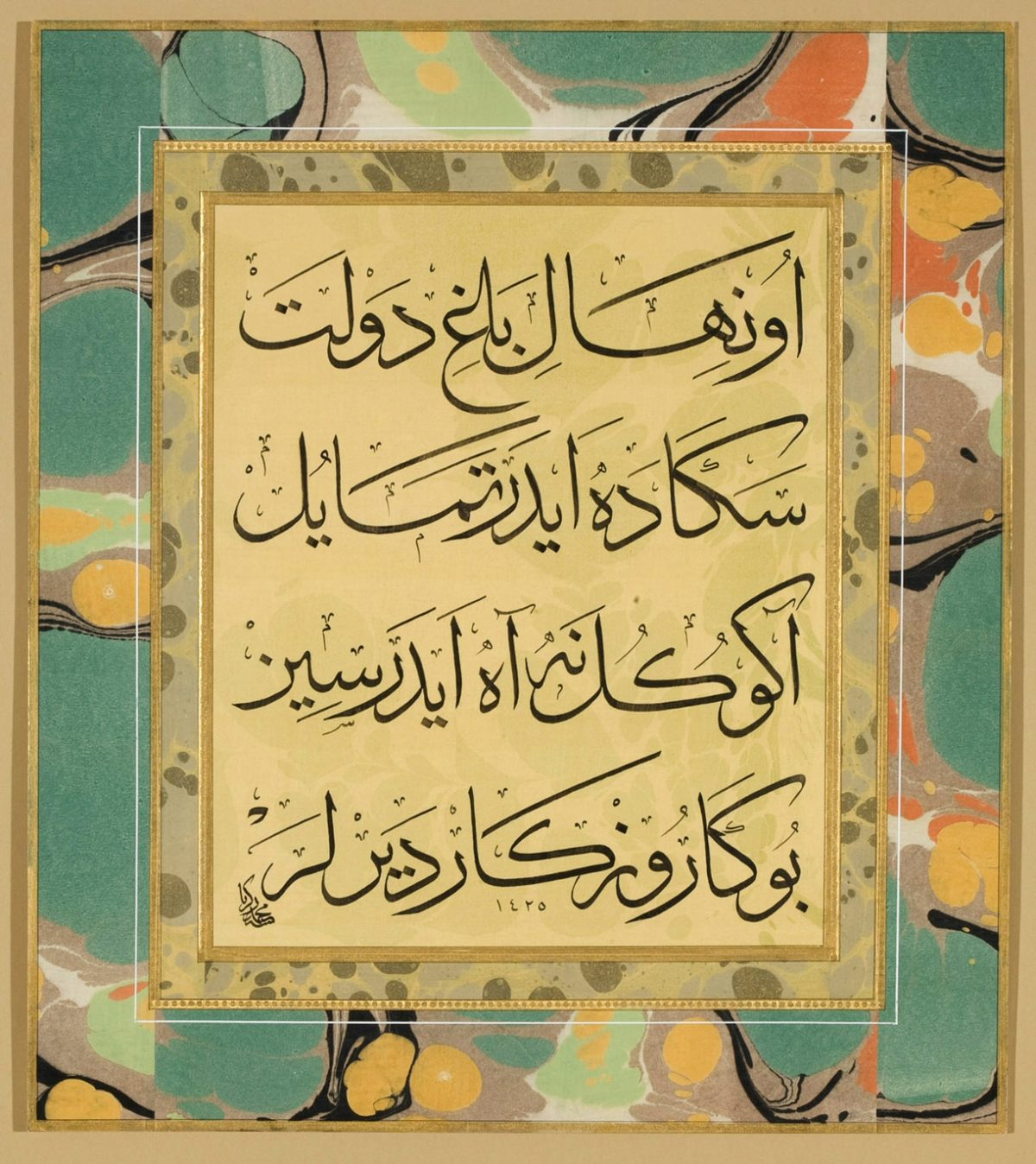Activity
Create a Personal Kit’alar
Objective: In this lesson, students create a kit’alar composed of the initials of their first and last name in Arabic.

Garden of Happiness, an Ottoman Turkish Poem, 2004, by Mohamed Sakariya (American, born 1942).
Content Standards (California)
HSS 7.2.3: Explain the significance of the Qur’an and the Sunnah as the primary sources of Islamic beliefs, practice, and law, and their influence in Muslims’ daily life. HSS 7.2.4: Discuss the expansion of Muslim rule through military conquests and treaties, emphasizing the cultural blending within Muslim civilization and the spread and acceptance of Islam and the Arabic language. VPA/VA 6.2.5: Select specific media and processes to express moods, feelings, themes, or ideas.
Materials
- Arabic Alphabet handout
- Rectangular cardboard
- Light brown paper (pre-cut so the dimensions are smaller than the cardboard)
- Tempura paint
- Decorative wrapping paper
- Brushes
- Glue
- Lined paper
Overview
With simple beginnings in the pre-Islamic period, Arabic script developed rapidly after the rise of Islam into not only a writing system but also an art form. Because the revelations of God to Muhammad were in Arabic, it became the language of Islam and the reading and writing of Arabic play a central role in the religion. In the first chapter of the Qur’an, God is described as “most generous, teaching by the pen” (96/3-4), and God is often described in Islamic poetry as the eternal calligrapher.
A kit’alar is a calligraphic work written on a rectangular piece of paper pasted onto a cardboard backing. Equal margins are left around the calligraphy in which the artist decorates with marbled paper (ebru) or illumination.
Procedure
- As a class, examine Islamic art. Discuss with students how calligraphers carefully layed out the letters in symmetrical compositions. The photo above shows a kit’a (panel section).
- Describe to students the significance of calligraphy in Islamic art and the high status of the calligrapher in Islamic society. Explain to students the characteristics of Arabic writing, stressing that it is written only in cursive and is read from right to left (a cover of a book is flipped from left to right as is done in Chinese).
- Have students write their last and then first initial at the top of the paper. Have students find the letters closest to their initials on the Arabic Alphabet handout. The Arabic alphabet has only three vowels: a, i, and u. These long vowels can be changed into short vowels using diacritical marks. If students are not able to find an exact match, have them use the letter that sounds the closest.
- Have students practice writing the Arabic equivalent beneath their initials.
For Middle School Students Only:
Have students create a reed.
-
- Have students cut the end of a tongue depressor at angle about 35–40 degrees and then lightly sand it.
- On the cut end of the tongue depressor, make a one-inch slit using an exacto knife.
- Dip the “reed” into the ink. When writing, hold it similar to the way Western calligraphy pen. Practice writing the name using the ink and “reed.”
- Next, have students write their names name on the brown paper. Use a brush to touch up the letters. Next, they should lightly sketch their Arabic “initials’” on the brown paper in large lettering. They may want to imitate the calligraphic script varying the thickness of the line as shown on the worksheet.
For Elementary School Students:
Have students paint over the letters with black tempura ink.
-
- Paint small flower and plant motifs around the letters. Set it aside to dry.
- Have students cut a piece of decorative wrapping paper so it is one inch larger than the cardboard. Paste it onto the cardboard. Fold over the edges and glue them down.
- Have students paste their paintings in the center of the wrapped cardboard.





